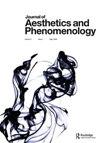Turner as a Daoist Sage
IF 0.2
0 PHILOSOPHY
引用次数: 0
Abstract
ABSTRACT In this paper, I provide a cross-cultural comparison between the life and work of the English land- and seascape painter, J.M.W. Turner, and the conception of aesthetic experience and artisanship found in classical Chinese Daoism. I argue that Turner exhibits certain key features of the Daoist sage. By developing some recent interpretations of his life and work, I claim that Turner, especially in his later seascapes, exhibited an approach to aesthetic experience that involves the artist’s total absorption into and identification with the natural process with which he is concerned. Next, I show how the Daoist approach to aesthetics and artisanship similarly focuses on the artist’s capacity to identify with the power and source of the world they aim to aesthetically experience. The central motif in both certain of Turner’s later work and the Daoist approach to aesthetic creativity is the figure of the vortex. By becoming the center of a natural vortex, and even the vortex that is nature itself, the Turnerian and Daoist artist experiences and embodies the wisdom of accessing and identifying with nature’s omnipotence. Such wisdom is thus expressed in the artwork by emphasizing the fundamental dynamism and vagueness of all things. I conclude by claiming that if one reads Turner as a Daoist sage, then a novel model for the aesthetic experience and appreciation of nature can be offered. I call this “the identification model” and recommend it being slotted into our taxonomy of contemporary options within environmental aesthetics.道圣的特纳
摘要在本文中,我对英国陆地和海景画家J.M.W.特纳的生活和工作与中国古典道教中的审美经验和工艺概念进行了跨文化比较。我认为特纳展现了道家圣人的某些关键特征。通过对他的生活和作品进行一些最近的解读,我声称特纳,尤其是在他后来的海景中,展示了一种美学体验的方法,包括艺术家对他所关注的自然过程的完全吸收和认同。接下来,我将展示道家美学和工艺的方法如何同样关注艺术家认同他们旨在审美体验的世界的力量和来源的能力。在特纳后期的某些作品和道家美学创作方法中,中心主题都是漩涡的形象。通过成为一个自然漩涡的中心,甚至是自然本身的漩涡,特纳和道家艺术家体验并体现了接近和认同自然无所不能的智慧。因此,这种智慧在艺术作品中通过强调所有事物的基本动态性和模糊性来表达。我最后声称,如果有人把特纳读成一位道家圣人,那么就可以为自然的审美体验和欣赏提供一个新颖的模式。我称之为“识别模型”,并建议将其纳入我们对环境美学中当代选择的分类中。
本文章由计算机程序翻译,如有差异,请以英文原文为准。
求助全文
约1分钟内获得全文
求助全文

 求助内容:
求助内容: 应助结果提醒方式:
应助结果提醒方式:


